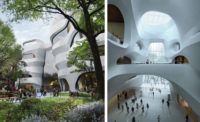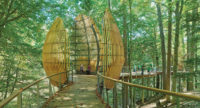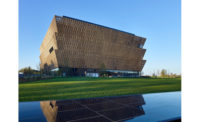American Museum of Natural History Taps wHY for Major Renovation of Northwest Coast Hall

The Northwest Coast Hall collection includes 19th- and early 20th-century objects from the First Nations of the Pacific Northwest (Alaska through British Columbia and Washington State).
Photo © AMNH/M. Shanley

Kulapat Yantrasast, founding partner and creative director of wHY Architecture, spoke at the announcement event on Monday.
Photo © Architectural Record

Representatives from native communities in the Pacific Northwest joined AMNH leadership for the announcement event on Monday.
Pictured, from left to right: Garfield George, also known as Kaa-xoo-auxch, head of the Raven Beaver House of Angoon/Dei Shu Hit “End of the Trail House,” Tlingit; Ron Hamilton, also known as Haa’yuups, head of the House of Takiishtakamlthat-h, of the Huupach'esat-h First Nation, Nuu-chah-nulth; Nika Collison, also known as Jisgang, representative of the Ts'aahl clan of the Haida Nation; and Kulapat Yantrasast of wHY.
Photo © Architectural Record

Museum president Ellen Futter spoke at the announcement event on Monday.
To her left: Lewis W. Bernard, chairman of the museum’s Board of Trustees; Peter Whiteley, curator of North American Ethnology; and Bill Cranmer, also known as Kwaxalanukwame’ ‘Namugwis, a hereditary chief of 'Namgis First Nation, Kwakwaka’wakw.
Photo © Architectural Record

Peter Whiteley, curator of North American Ethnology, discussed some of the collection’s highlights on a behind-the-scenes tour after the announcement event on Monday.
Photo © Architectural Record

The Northwest Coast Hall collection includes 19th- and early 20th-century objects from the First Nations of the Pacific Northwest (Alaska through British Columbia and Washington State).
Photo © AMNH/M. Shanley

The restoration of the Northwest Coast Hall includes a major effort by the museum’s Objects Conservation Laboratory to conserve more than 1,000 items from the Northwest Coast collection.
Photo © AMNH/C. Chesek

The restoration of the Northwest Coast Hall includes a major effort by the museum’s Objects Conservation Laboratory to conserve more than 1,000 items from the Northwest Coast collection.
Photo © AMNH/C. Chesek








Architects & Firms
The American Museum of Natural History (AMNH) in New York has announced plans for a major renovation and restoration of its Northwest Coast Hall by wHY. The multi-year, $14.5-million project is slated for completion in 2020, during the museum’s 150th anniversary celebration.
At the kick-off event on Monday morning, representatives from four Native American communities of the Pacific Northwest joined AMNH leadership in making the announcement, sharing their perspectives on the project, as well as songs and prayers from their cultures. Kulapat Yantrasast, founding partner and creative director of wHY, followed.
“As I was listening to the remarks and the songs, I felt every object in this room resonate with that, and I felt, as an architect, how can we make that happen?” Yantrasast asked. “I think our first task, very first step is to really listen and engage, convene and explore. We want to bring in a refreshed way to honor and celebrate the cultures here—not just for the objects in this great hall, but the living cultures, the people whose cultures are represented in this room.”
Built in 1899, the Northwest Coast Hall (conceived by curator Franz Boas, the “father of American anthropology”) was the AMNH’s first cultural gallery. Today, the collection contains some 1,800 objects related to indigenous peoples of the Pacific Northwest, and according to Vice President of Exhibition Lauri Halderman, the renovation will allow curators to rethink what items are on display: some pieces may go into storage, while others that have been packed away will come into the public eye.
Museum President Ellen Futter, who praised wHY’s “exquisite sensitivity” working with historic spaces (including, recently, the Marciano Art Foundation) , stressed the importance of exhibits and displays “explicitly reinforcing that these are ongoing living cultures with contemporary voices.” In that vein, Curator of North American Ethnology Peter Whiteley suggested that the renovated Hall may include space for temporary exhibitions showcasing new objects created by the native peoples of the Pacific Northwest.
The undertaking also includes a major conservation and preservation effort, and in-house conservators are already well underway cleaning and preserving six of the collection’s 78 ornately carved totem poles. Most range in height from 12 to 15 feet and require extremely detailed attention, according to Director of Conservation Judith Levinson. wHY, which has offices in both Los Angeles and New York, will consult with the conservation and curatorial staff on how to best light and mount the delicate artifacts, as well as control the temperature and humidity of their environment.
All parties will also work with members of the First Nations and other native and non-native scholars to determine how to display objects in a way that respects their cultural significance, with Whitely noting that the museum does not plan to “shy away from the problematic aspects of collecting,” but rather intends to address them “in a way that moves toward social justice.”
Ron Hamilton, head of the House of Takiishtakamlthat-h, of the Huupach'esat-h First Nation, was one of the guests of honor who spoke during the morning announcement. He remembered first coming to the AMNH some 50 years ago. “I came here as a young man to look at things that came from my home,” he said. “I am so grateful to be called here today, to be among these illustrious individuals who are going to help shape what this institution is going to say.”
Hamilton, who is also known by the name Haa’yuups, continued: “These objects are interesting, they’re beautiful, they’re powerful, and they’re loaded with meaning. And it strikes me that it’s high time that we begin to get under the skin of these things; stop analyzing their surfaces and start looking at what they really mean.”
No renderings of wHY’s scheme have yet been released. Meanwhile, Studio Gang is leading an ambitious expansion and project to create the 245,000-square-foot Richard Gilder Center for Science, Education, and Innovation project.











